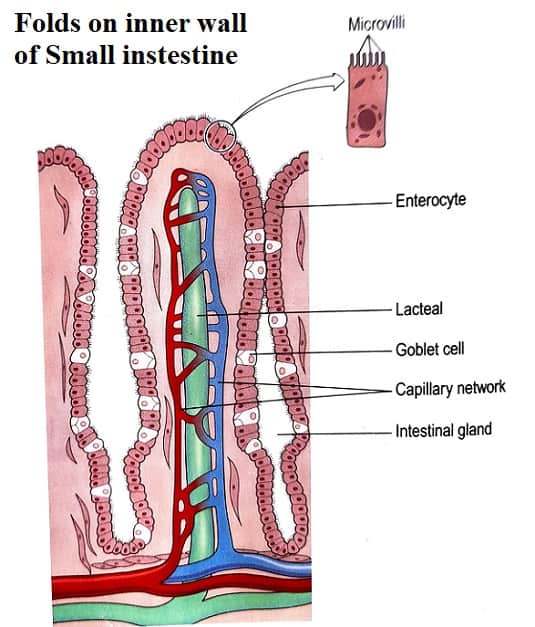The small intestine plays a vital role in our digestive system, acting as a gateway for absorbing essential nutrients from the food we eat. Its design is remarkably intricate, maximizing the efficiency of nutrient absorption.
In this article, we will delve into the fascinating world of the small intestine, exploring its anatomy, the role of its specialized structures, and the processes involved in absorbing digested food.
Anatomy of the Small Intestine: The Gateway to Nutrient Absorption
The small intestine is a long, coiled tube measuring around 20 feet in length, making it the longest part of the digestive tract. It is divided into three segments: the duodenum, jejunum, and ileum. The inner surface of the small intestine is lined with millions of finger-like projections called villi. These villi, in turn, are covered with even smaller, hair-like structures known as microvilli.
Role of Villi and Microvilli: Maximizing the Absorptive Surface Area
A. Structure and Function of Villi:
Villi are responsible for increasing the surface area available for absorption within the small intestine. They resemble tiny fingers and are densely packed, giving the intestinal lining a velvety appearance. Each villus contains blood vessels and a lymphatic vessel called a lacteal, which play crucial roles in nutrient absorption.
B. Microvilli: The Brush Border of the Small Intestine:
Microvilli, also known as the brush border, are microscopic extensions found on the surface of each villus. These tiny projections vastly increase the absorptive surface area of the small intestine. They contain various digestive enzymes that facilitate the breakdown of complex nutrients into simpler forms for absorption.
III. The Process of Nutrient Absorption: From Digestion to Utilization
A. Digestion in the Small Intestine:
The small intestine receives partially digested food from the stomach. Here, digestive enzymes, including amylase, lipase, and proteases, break down carbohydrates, fats, and proteins, respectively. The resulting simpler molecules are ready for absorption.
B. Transport Mechanisms: Getting Nutrients Across the Intestinal Barrier
- Simple Diffusion: Small molecules such as water and lipid-soluble substances can pass directly through the cell membranes of the small intestine’s absorptive cells by simple diffusion.
- Facilitated Diffusion: Some molecules, such as certain sugars and amino acids, require specific carrier proteins to facilitate their transport across the cell membrane.
- Active Transport: Certain nutrients, including glucose and amino acids, are absorbed against a concentration gradient through active transport. This process requires energy and specific carrier proteins.
- Endocytosis: Large molecules such as fats and fat-soluble vitamins are absorbed via endocytosis. The absorptive cells envelop these substances and transport them into the cell through vesicles.

C. Absorption of Specific Nutrients:
- Carbohydrates: Monosaccharides, such as glucose and fructose, are absorbed into the bloodstream and transported to cells for energy production.
- Proteins: Amino acids are absorbed and utilized for various bodily functions, including tissue repair, enzyme synthesis, and hormone production.
- Fats: Fatty acids and glycerol are absorbed into the lymphatic system through the lacteals in the villi. From there, they enter the bloodstream, providing energy and supporting various physiological processes.
- Vitamins and Minerals: The small intestine also absorbs vitamins and minerals, which are essential for maintaining overall health and supporting various bodily functions.
IV. Regulation of Nutrient Absorption: Ensuring Optimal Uptake
The small intestine’s absorption process is tightly regulated to ensure optimal nutrient uptake. Hormones such as secretin, cholecystokinin (CCK), and gastrin play crucial roles in regulating digestion and absorption. These hormones stimulate the release of digestive enzymes and control the movement of food through the digestive tract.
V. Factors Affecting Small Intestine Function: The Role of Health and Lifestyle
A. Diseases and Disorders Impacting Absorption:
- Celiac Disease: This autoimmune disorder damages the lining of the small intestine, leading to impaired nutrient absorption, especially in response to gluten.
- Crohn’s Disease: Inflammation in the small intestine can result in reduced absorption capacity and nutrient deficiencies.
- Irritable Bowel Syndrome (IBS): Although not directly related to malabsorption, IBS can cause gastrointestinal symptoms that may impact the absorption process.
B. Impact of Lifestyle and Diet Choices:
- Fiber Intake: A diet rich in fiber promotes healthy digestion and regular bowel movements, aiding nutrient absorption.
- Hydration: Proper hydration supports the flow of nutrients through the small intestine, facilitating absorption.
- Alcohol and Caffeine Consumption: Excessive alcohol and caffeine intake can interfere with nutrient absorption and cause gastrointestinal disturbances.
FAQs Section
Villi are finger-like projections that line the inner surface of the small intestine. Their primary function is to increase the surface area available for nutrient absorption. Each villus contains blood vessels and a lymphatic vessel called a lacteal, which help in the transport of absorbed nutrients into the bloodstream and lymphatic system, respectively.
Microvilli, also known as the brush border, are tiny hair-like structures found on the surface of each villus. They further increase the absorptive surface area of the small intestine. Microvilli contain digestive enzymes that facilitate the breakdown of complex nutrients into simpler forms, enhancing their absorption.
Several transport mechanisms are involved in nutrient absorption in the small intestine. These include simple diffusion, facilitated diffusion, active transport, and endocytosis. Simple diffusion allows small molecules to pass directly through the cell membranes, while facilitated diffusion requires carrier proteins. Active transport requires energy and specific carrier proteins to transport nutrients against a concentration gradient. Endocytosis is involved in the absorption of large molecules such as fats and fat-soluble vitamins.
The small intestine absorbs various nutrients, including carbohydrates, proteins, fats, vitamins, and minerals. Carbohydrates are broken down into monosaccharides such as glucose and fructose, which are then absorbed into the bloodstream. Proteins are broken down into amino acids and absorbed for various bodily functions. Fatty acids and glycerol from fats are absorbed into the lymphatic system and bloodstream. Additionally, vitamins and minerals are also absorbed to support overall health and bodily functions.
Conclusion: The Remarkable Design of the Small Intestine
The small intestine’s intricate design is optimized for efficient nutrient absorption. The arrangement of villi and microvilli significantly increases the surface area available for absorption, while various transport mechanisms ensure the uptake of essential nutrients.
By understanding the small intestine’s structure and function, we can appreciate the importance of maintaining its health through a balanced diet and lifestyle choices. Ultimately, a healthy small intestine leads to optimal nutrient absorption and supports overall well-being.
Remember, the small intestine is a complex organ, and this article provides a comprehensive overview of its design and function. You can further expand on each section, include scientific studies or examples, and provide practical tips for maintaining a healthy small intestine for your readers.





